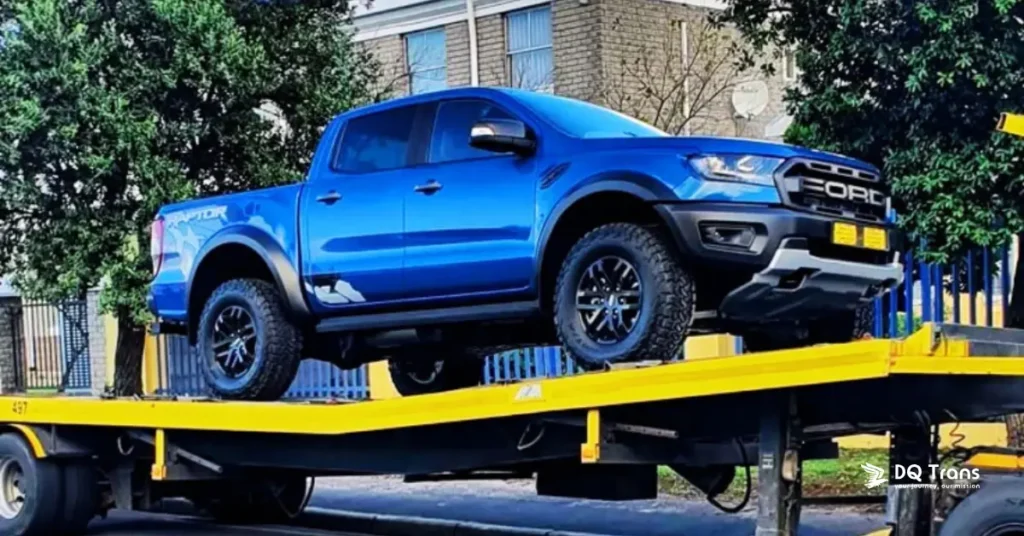You want your car picked up and delivered at your addresses.
You want clear steps, clear timing, and clear paperwork.
Door-to-door auto transport gives you that outcome.
Door-to-door means the driver meets you at or near your pickup and delivery locations.
You avoid terminals when access allows.
You reduce transfers.
You keep the chain of custody simple.
You control handoff and inspection at both ends.
This guide explains the process from quote to delivery.
You will see how scheduling works.
You will see how inspections work.
You will see how driver rules shape ETAs.
You will also learn how to verify a carrier and protect your shipment.
What Door-to-Door Means in Practice
The goal is curbside pickup and curbside delivery.
The driver operates a large truck.
Large trucks need space, height clearance, and safe turns.
If your street is narrow, weight-restricted, or has low trees or wires, the driver selects a safe nearby spot.
Common spots are wide streets, shopping centers, and community entrances.
You still get a direct handoff with inspection at that meeting point.
Terminals are storage yards.
Door-to-door avoids terminals in most cases.
Terminals can add transfers and waiting time.
You choose terminal shipping only if you prefer it or access is not possible.
Key takeaway: door-to-door means direct handoff at a safe location tied to your addresses.
This saves time and reduces handling.
Open vs Enclosed Car Shipping
Open carriers move multiple vehicles on open trailers.
Open is common, available, and efficient.
Most daily drivers ship open.
Enclosed carriers place cars in covered trailers.
Enclosed protects sensitive finishes.
Owners of classics, exotics, and low-clearance cars choose enclosed.
Choose open when budget and speed matter.
Choose enclosed when protection matters.
Both options support door-to-door when access allows.
Ask yourself: what is the value of the vehicle, finish, and time?
Match the trailer type to your risk tolerance and schedule.
Your quote reflects the trailer type, route demand, and timing.
The Step-by-Step Process
1) Request a Quote
Share origin, destination, year, make, model, and condition.
Share a target pickup window.
Note access limits if known.
Example: gated community, tight street, HOA rules.
You receive a quote based on route demand, trailer type, and timing.
Quotes can shift with season and fuel.
Flexibility helps.
2) Vet the Carrier or Broker
Ask for USDOT and MC numbers.
Check the FMCSA Company Snapshot to confirm status, authority, and insurance.
Ask who holds the cargo insurance and for how much.
Ask who you call for updates.
Confirm if you are working with a carrier or a broker.
A broker arranges the shipment with a carrier.
Both models can work when transparent.
3) Book and Schedule Dispatch
When you accept the quote, dispatch secures a truck and confirms the pickup window.
You receive the driver’s name and contact close to pickup.
You get updates if timing changes.
Pickup and delivery windows reflect distance, routing, and legal driver hours.
Expect a window, not an exact minute.
Stay reachable on the phone number you provided.
4) Prepare the Vehicle
Wash the exterior for clear inspection.
Remove toll tags.
Remove loose external items.
Keep fuel at about a quarter tank.
Remove personal items per policy.
Fold mirrors and secure antennas.
Note ground clearance and modifications.
If the car runs and steers, loading is straightforward.
If the car is inoperable, a winch or special gear is required.
Flag this at booking so the right equipment arrives.
5) Pickup Inspection and BOL
Meet the driver at the agreed location.
Walk around the car together.
Note pre-existing marks on the Bill of Lading (BOL).
Take date-stamped photos from all sides, plus close-ups.
Sign the BOL after both parties agree.
The driver loads the car and secures it.
You receive a copy or photos of the BOL.
6) In-Transit Updates
You receive ETA updates during transit.
Weather, traffic, and road restrictions can shift timing.
Drivers follow federal Hours of Service rules that limit daily driving and require breaks.
If access becomes a problem near delivery, the driver proposes a safe meeting point.
This keeps delivery legal and safe.
7) Delivery Inspection and POD
Meet the driver at the agreed spot.
Inspect the car before unloading if possible, then after unloading.
Compare with pickup photos and the BOL notes.
If you see new damage, document it on the BOL and take photos.
Sign the Proof of Delivery (POD).
Payment terms follow your order confirmation.
Methods include card on file, cashier’s check, or other arranged methods.
Keep copies of the BOL and POD.
Transit Time, Driver Rules, and Realistic ETAs
Drivers must follow federal Hours of Service rules.
These rules exist for safety.
They cap driving time and define rest.
Key rules for property carriers:
- Up to 11 hours driving after 10 hours off duty.
- A 14-hour on-duty window that includes driving and non-driving work.
- A 30-minute break after 8 hours of driving.
- Split sleeper options for required rest.
- Up to a 2-hour extension during adverse conditions.
These rules shape daily mileage.
Weather and traffic also matter.
So do road closures and appointment windows.
As a result, you receive delivery windows, not precise times.
Plan for a window at both ends.
Keep your phone on for driver updates.
Share backup contacts if you travel.
Pricing Factors You Control
Flexibility on dates lowers cost risk.
Rigid dates reduce truck options.
Trailer type changes price.
Open is common and widely available.
Enclosed adds protection and changes capacity.
Operable vehicles load faster.
Inoperable units need extra gear.
That adds time and cost.
Routes with many carriers price smoother.
Remote areas need routing creativity.
Meeting at a nearby hub can help.
Share constraints early.
You get a realistic quote.
You get the right equipment.
Risk, Insurance, and Claims
Your carrier holds cargo coverage per policy.
Your order confirmation lists the responsible party.
Ask for proof before pickup.
Your best protection is documentation.
Take photos at pickup.
Take photos at delivery.
Match them to the BOL.
If you see new damage at delivery, write it on the BOL before signing.
Collect the driver’s photos if available.
Contact the claims desk listed on your order.
Submit photos, BOL, and repair estimates.
Clean paperwork and clear photos speed resolution.
Most issues resolve when the documents match the facts.
Fraud Prevention and Carrier Verification
Verify USDOT and MC numbers in the FMCSA SAFER database.
Confirm active authority and insurance snapshots.
Know the role of each party.
A broker arranges the move and assigns a carrier.
A carrier owns the trucks and drivers.
Both models can work when roles are clear.
If you suspect fraud, report it to the FTC.
Keep copies of emails, quotes, and receipts.
Submit your complaint at ReportFraud.ftc.gov.
These steps reduce risk and keep your shipment on track.
When Door-to-Door Is Not Ideal
Some locations restrict trucks.
Apartments with tight turns can block access.
Private roads can restrict weight.
Low-clearance cars can need special ramps.
Steep driveways can be unsafe.
In these cases, meet at a nearby safe area.
Remote locations can add time.
Meeting at a town center can speed delivery.
Ask your dispatcher for options.
Conclusion
Door-to-door auto transport keeps the process simple.
You hand off the car at or near your address.
You inspect at both ends.
You reduce transfers and wait time.
Plan your pickup window.
Verify USDOT and MC in SAFER.
Match the trailer to your needs.
Document inspections with photos.
Keep communication open.
These steps protect you and your car.
They set clear expectations.
They keep transit predictable.
FAQs
What does door-to-door mean?
Pickup and delivery at or near your addresses, using a safe and legal meeting point when needed.
Do drivers reach my exact driveway?
Only if the street allows safe access. Otherwise the driver sets a nearby meeting spot.
Should I choose open or enclosed?
Open fits most daily drivers. Enclosed fits high-value, specialty, or low-clearance cars.
How do I prepare my car?
Wash the exterior, remove toll tags and loose items, keep about a quarter tank, and share access limits.
How are pickup and delivery windows set?
By route, carrier availability, and legal driver hours. Weather and traffic can shift timing.
How do I verify a carrier or broker?
Check USDOT and MC in the FMCSA Company Snapshot. Confirm insurance and authority.
What if I see damage at delivery?
Note it on the BOL before signing. Take photos. Contact the claims desk with documents.


